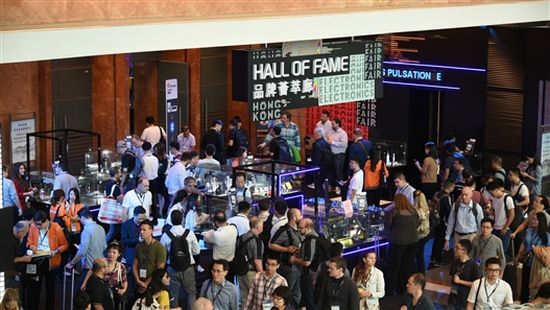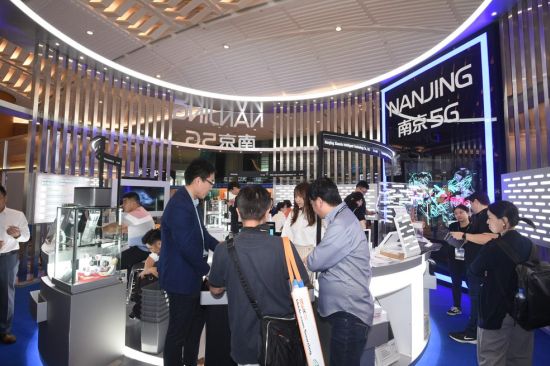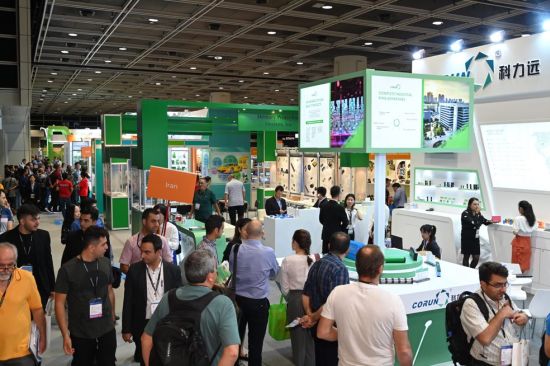
HONG KONG, Nov 14, 2019 - (ACN Newswire) - As the autumn trade fair season draws to a close, the Hong Kong Trade Development Council (HKTDC) has revealed that more than 9,600 exhibitors and nearly 156,000 buyers from 165 countries and regions attended the seven fairs it organised in October and November. Among specific markets, there was an increase in the number of buyers coming from Turkey, Brazil, Iran, Vietnam and Macao.

The seven autumn trade fairs organised by the Hong Kong Trade Development Council welcomed nearly 156,000 visitors from 165 countries and regions.

The Tech Hall at the Hong Kong Electronics Fair (Autumn Edition) featured the Nanjing 5G Pavilion along with the Symposium on Innovation & Technology, held under the theme "Intelligent Connectivity: 5G and Beyond".

electronicAsia showcased a bevy of cutting-edge production technologies and provided an important sourcing platform for the upstream supply chain in the electronics industry.
The seven fairs were the HKTDC Hong Kong Electronics Fair (Autumn Edition), electronicAsia, jointly organised with MMI Asia Pte Ltd, the HKTDC Hong Kong International Lighting Fair (Autumn Edition), the HKTDC Hong Kong International Optical Fair and the HKTDC Hong Kong International Wine & Spirits Fair, all held at the Hong Kong Convention and Exhibition Centre (HKCEC), and the HKTDC Hong Kong International Outdoor and Tech Light Expo and Eco Expo Asia, jointly organised with Messe Frankfurt (HK) Ltd, held at AsiaWorld-Expo.
The seven HKTDC autumn fairs welcomed more than 7,300 exhibitors and attracted nearly 95,000 buyers from Mainland China and overseas. This influx of visitors to Hong Kong generated ample business opportunities for the city's tourism, catering and service sectors. According to Hong Kong Tourism Board statistics, the per capita spending of overnight MICE (meetings, incentives, conventions and exhibitions) visitors averages HK$8,218. Based on this figure, it is estimated that the seven fairs generated close to HK$900 million in income for Hong Kong's tourism and exhibition-related industries.
Buyers and exhibitors view Hong Kong as important trading platform
Benjamin Chau, HKTDC Deputy Executive Director, said: "Despite the internal and external challenges that Hong Kong has been facing, all seven HKTDC fairs and associated events ran without a hitch. Surveys conducted during the fairs found that 97% of responding buyers view the Hong Kong fairs as one of the most popular channels to find new suppliers, while 96% of responding exhibitors consider the Hong Kong fairs to be the most effective in helping them reach new buyers. More than half (56%) of responding exhibitors chose to launch their new products at the Hong Kong fairs, reflecting that Hong Kong continues to be an important platform for global trade."
Mr Chau added that, during the seven fairs, the HKTDC viewed the safety of exhibitors and buyers as its top priority amid the ongoing social issues in Hong Kong. Various measures were implemented to strengthen support to visitors and exhibitors, including enhancing transport services and ramping up its business-matching service to enhance buyer-exhibitor connections. "We will continue to provide supportive services in the future to facilitate industry participants from around the world to source and do business in Hong Kong, and to generate more business opportunities for small and medium-sized enterprises," he said.
The Buyer Concierge Desks newly set up by the HKTDC at the seven fairs, together with the Council's regular business-matching services, led to a total of 7,000 meetings being successfully arranged, creating more opportunities to help exhibitors and buyers connect. For more information on the support services offered by the HKTDC during the autumn fairs, please visit https://bit.ly/2KsrhcH.
Survey: Global economic fluctuations seen as major business challenge
An independent research agency commissioned by the HKTDC interviewed 1,724 exhibitors and buyers during the Autumn Electronics Fair, the Autumn Lighting Fair and the Outdoor and Tech Light Expo. The survey showed that respondents considered fluctuations in the global economy (43%) to be the top business challenge this year, followed by an increase in operating costs (36%) and fluctuating raw material prices (29%), while only 8% of respondents were concerned about the unstable political environment in Hong Kong.
As Mainland China and the United States continue to make progress on trade negotiations, respondents expressing pessimism over the likelihood of a resolution dropped from 48% last year to 33% this year. A total of 45% of respondents remained neutral while 23% expressed optimism.
Industry: Middle East, ASEAN seen as most promising emerging markets
Western Europe (25%), North America (20%) and Japan (14%) were seen as the traditional markets that respondents from the electronics and lighting industries most hoped to develop. In terms of emerging markets, Association of Southeast Asian Nations (ASEAN) countries (10%), Mainland China (8%) and the Middle East (6%) were the most favoured.
As for market outlook, most respondents viewed Korea (63%), Australia and New Zealand (55%) and Western Europe (53%) to have the best growth prospects among traditional markets, while the Middle East (71%) and ASEAN counties (67%) topped the emerging markets.
Many ASEAN buyers adopted a proactive attitude when sourcing, including Vietnamese buyer Dung Minh Nguyen, Director of HDP Vietnam Technology, who visited the Autumn Lighting Fair. "Within a few days, we identified more than a dozen potential suppliers from Hong Kong and Mainland China. We plan to order at least US$50,000 worth of products relating to commercial lighting for hotel projects, outdoor lighting and track lights from each of these new suppliers," he said.
Demand for smart products continues to grow
In terms of product trends, the global demand for smart products continues to gather pace. The Autumn Electronics Fair survey found that 81% of respondents were willing to pay up to an additional 20% for electronics products with smart home applications. Three quarters of industry players (75%) held an optimistic view on the market potential of products incorporating augmented reality (AR) and virtual reality (VR) technologies, while 71% saw favourable prospects for robotics. Medical applications (45%) were selected as having the greatest growth potential over the next two years, a significant increase of 21 percentage points compared to last year's findings.
To help industry participants stay abreast of the latest trends, the HKTDC enhanced the innovation and technology elements at all seven fairs. For example, the Autumn Lighting Fair's Connected Living, Smart Home zone showcased an assortment of smart living concepts, technologies and products; the Optical Fair's IT Solutions, Shop Fittings & Equipment zone presented innovative eyewear technologies; the Green Transportation zone at Eco Expo Asia featured eco-friendly solutions such as electric vehicles; and the Autumn Electronics Fair debuted the Nanjing 5G Pavilion at the Tech Hall.
Meanwhile, the Startup zone at the Autumn Electronics Fair presented an array of exciting new concepts from innovative young companies. One of the exhibitors was OliveX (HK) Limited, which has developed an interactive artificial intelligence (AI)-enabled smart mirror. Keith Rumjahn, the company's CEO, said: "This is our first time to participate in the Startup zone at the Autumn Electronics Fair. The results have far exceed our expectations. We have met with two potential distributors from Spain and the United Arab Emirates. The Startup zone provides a cost-effective platform for us to maximise the exposure of our new product and look for potential distributors."
Multiple forums and seminars were organised during the fairs to examine current technological trends and bring participants up to speed on the latest industry developments. These included the Autumn Electronics Fair's Symposium on Innovation & Technology, the Autumn Lighting Fair's forum on the theme "Ecosystem of Connected Living", Eco Expo Asia's Eco Asia Conference, and the 17th Hong Kong International Optometric Symposium at the Optical Fair.
Summary of survey results:
New markets that industry players have the most desire to enter
Traditional markets
2019 survey / 2018 survey
Western Europe (25%) / Western Europe (18%)
North America (20%) / North America (11%)
Japan (14%) / Japan (7%)
Emerging markets
2019 survey / 2018 survey
ASEAN countries (10%) / Mainland China (10%)
Mainland China (8%) / ASEAN countries (9%)
Middle East (6%) / India (6%)
Markets considered to have the best growth potential in the coming two years
Traditional markets
2019 survey / 2018 survey
South Korea (63%) / Japan (77%)
Australia & New Zealand (55%) / South Korea (75%)
Western Europe (53%) / Western Europe/Taiwan/Hong Kong (69%)
Emerging markets
2019 survey / 2018 survey
Middle East (71%) / South Africa (79%)
ASEAN countries (67%) / Mainland China (76%)
South Africa (64%) / Middle East/ASEAN countries (71%)
Photo download: https://bit.ly/2CThcBn
About HKTDC
The Hong Kong Trade Development Council (HKTDC) is a statutory body established in 1966 to promote, assist and develop Hong Kong's trade. With 50 offices globally, including 13 in Mainland China, the HKTDC promotes Hong Kong as a two-way global investment and business hub. The HKTDC organises international exhibitions, conferences and business missions to create business opportunities for companies, particularly small and medium-sized enterprises (SMEs), in the mainland and international markets. The HKTDC also provides up-to-date market insights and product information via trade publications, research reports and digital news channels. For more information, please visit: www.hktdc.com/aboutus. Follow us on Twitter @hktdc and LinkedIn.
Contact:
Natalie Wong, Tel: +852 2584 4472, Email: natalie.hy.wong@hktdc.org Sunny Ng, Tel: +852 2584 4357, Email: sunny.sl.ng@hktdc.org
Copyright 2019 ACN Newswire. All rights reserved. www.acnnewswire.com
